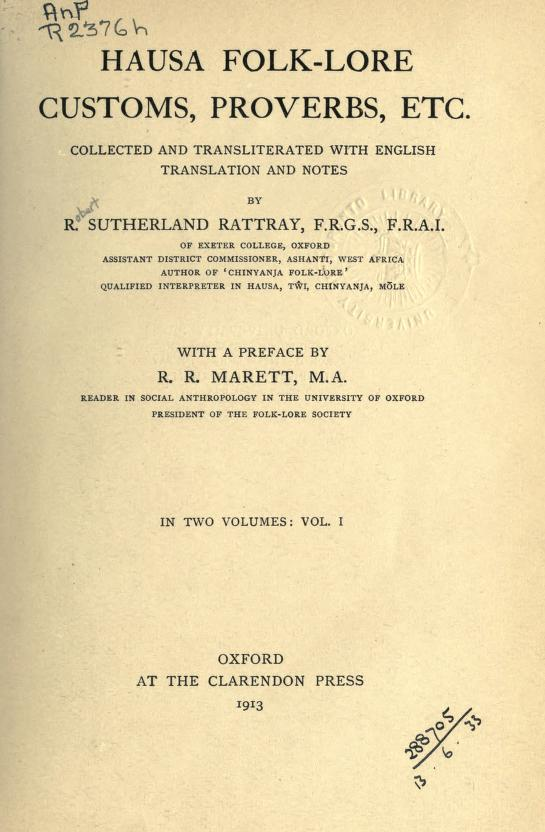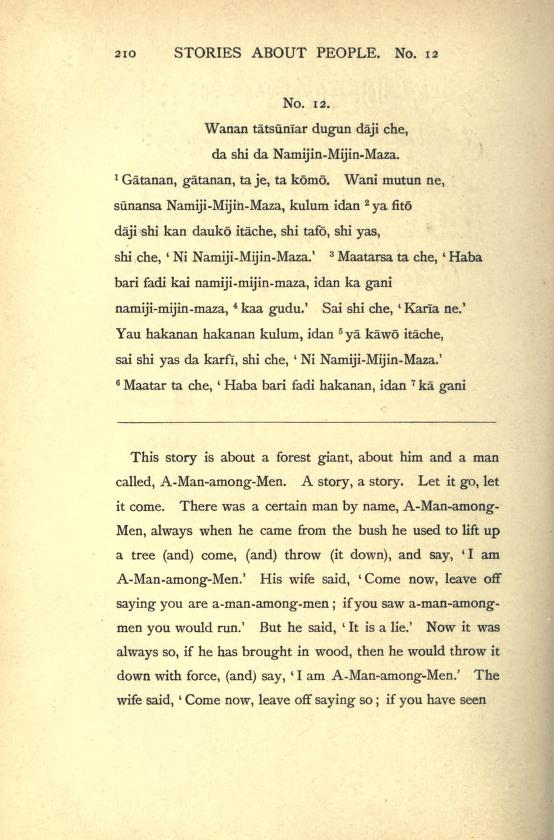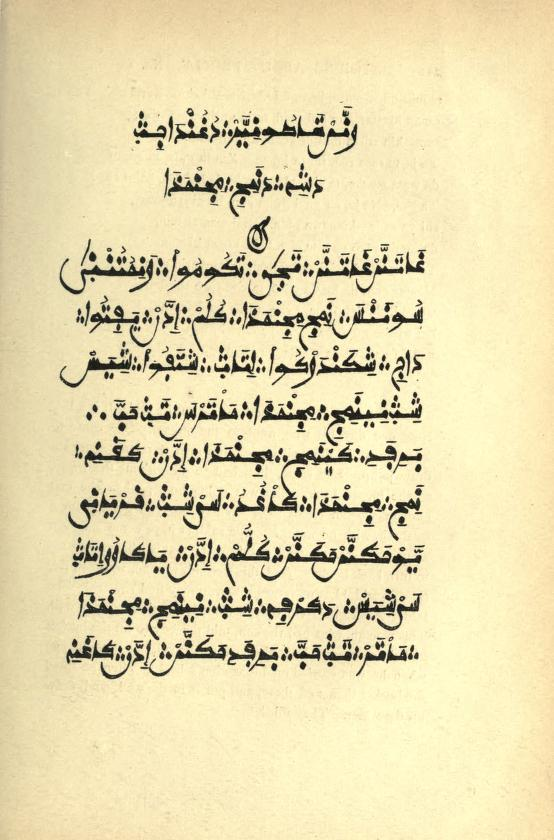Title of the work
Country of the First Edition
Country/countries of popularity
Original Language
First Edition Details
Robert Sutherland Rattray, " A Story about a Giant, and the Cause of Thunder ” in Hausa Folk-Lore: Customs, Proverbs, etc. Collected and Transliterated with English Translation and Notes. Vol. 1, Oxford: Clarendon Press, 1913, 210–231.
Available Onllne
A Story about a Giant and the Cause of Thunder (accessed: July 4, 2021).
Genre
Folk tales
Target Audience
Crossover
Cover

Retrieved from Internet Archive (accessed: July 2, 2021).
Author of the Entry:
Eleanor A. Dasi, The University of Yaounde I, wandasi5@yahoo.com
Peer-reviewer of the Entry:
Daniel A. Nkemleke, University of Yaounde 1, nkemlekedan@yahoo.com
Elizabeth Hale, University of New England, ehale@une.edu.au
Marta Pszczolińska, University of Warsaw, m.pszczolinska@al.uw.edu.pl

Robert Sutherland Rattray
, 1881 - 1938
(Author)
Robert Sutherland Rattray (1881–1938) was born in India. He was a Scottish anthropologist and an authority on the native peoples of West Africa. He was educated at Exeter College at Oxford University and held a diploma in anthropology. In 1902 he entered Civil Service in Africa, first, in British Central Africa and from 1907, on the Gold Coast. During the Great War he served in Togoland and received the MBE, in 1929, he was progressed to CBE. In each place he was sent to, he studied local languages and conducted anthropological research about folklore, religion, beliefs, customs, law, art, folktales and proverbs. In 1924 he was made head of the Anthropological Department in Ashanti/Asante in acknowledgment of his merits. His contribution to the detailed study of the Ashanti customs and folklore was based on personal observations, contacts with the Ashanti, and a thorough knowledge and understanding of their culture. On his retirement, R. S. Rattray was a lecturer of anthropological topics at Oxford and elsewhere. He was passionate about flying, one of the first to fly to West Africa, a pioneer of gliding. He founded a club of gliding at Oxford and a week later was killed in a glider flying accident.
His main works include: Some Folk-Lore Stories and Songs in Chinyanja: with English Translations and Notes (1907), Hausa Folk-Lore, Customs, Proverbs, etc.: Collected and Transliterated with English Translation and Notes (1913), Ashanti Proverbs: the primitive ethics of a savage people: translated from the original with grammatical and anthropological notes (1916), An Elementary Mōle Grammar with a Vocabulary of Over 1000 Words for the Use of Officials in the Northern Territories of the Gold Coast (1918), Ashanti (1923), Ashanti Law and Constitution (1929), Akan-Ashanti Folk-tales (1930), The Tribes of the Ashanti Hinterland (1932), The Golden Stool of Ashanti: a Sacred Shrine Regarded as a Symbol of the Nation's Soul, and Never Lost or Surrendered, Its True History, a Romance of African Colonial Administration (1935).
Source:
“Captain R. S. Rattray, C. B. E.”, Nature 3577.141 (1938): 904, 929. (accessed: July 2, 2021).
Bio prepared by Marta Pszczolinska, University of Warsaw, m.pszczolinska@al.uw.edu.pl

Maalam Shaihu (Author)
Maalam Shaihu (active in the early twentieth century) was one of the learned Hausas known as maalamai, who were the most respected and honoured members of the Hausa community in the Gold Coast and Nigeria. The use of Arabic corresponded at that time to the use of Latin in mediaeval Europe, the knowledge of Arabic was necessary for conducting any research about the Hausa culture. A maalam of the best class possessed all the language and literary skills and understanding of the Hausas. Thus, Shaihu cooperated with R. S. Rattray to gather Hausa stories and manuscripts and make the Hausa culture better known. Much of the work contained in Hausa Folk-Lore involved his translation from Arabic into Hausa, and Rattray’s translation into English from the Hausa. In 1907-1911 during Rattray’s journeys in West Africa and in England, Maalam Shaihu accumulated many hundreds of sheets of manuscripts. Thanks to his work the traditional lore lost nothing of its authenticity. It is worth mentioning that, by the grant of the government of the Gold Coast, Maalam Shaihu’s Arabic penmanship was preserved by facsimile reproduction of his Arabic text printed in the 1913 edition.
Source:
R. R. Marett, Preface; R. Sutherland Rattray, Author’s Note in R. S. Rattray, Hausa Folk-Lore, Oxford: Clarendon Press, 1913.
Bio prepared by Marta Pszczolińska, University of Warsaw, m.pszczolinska@al.uw.edu.pl
Summary
A long time ago, there lived a man and his wife. He called himself “A-Man–among-Men” (henceforth referred to here as “the pretender”) and was very confident of his strength. One day, his wife went out to draw water from a well but returned with an empty pot because the well was too deep. On her way back, she met a strange woman and her son, who were also on their way to the well. They happened to be family members of the real “A-Man-among-Men” (henceforth referred to here as “the real”). In curiosity, this woman asked her why she had to return with no water, and she told her she could not draw water because the well was very deep. The strange woman asked her to go back to the well with them. While there, her son mysteriously drew water from the well and filled all their pots. On their way back, the strange woman and her son took the road leading to the jungle, which actually led to their home, that is, where “the real” lived.
When the woman got home, she told her husband, “the pretender” about all that had happened and her husband asked her to take him to that location the next day. Before sunrise, her husband had armed himself ready to meet “the real”. When they arrived at the well, her husband saw the strange woman and his son and pretended he was unable to draw water from the well because it was very deep. Unfortunately, the bucket almost dragged him down into the well. Surprisingly, the little boy helped him out and drew enough water for him.
Later his wife told him that the strange woman and the boy are family members of “the real” whom he wanted to meet. Subsequently, he left with the woman and her son, but when they arrived at their home “the real” had left for the forest. He was a huge man who sounded like a tornado when he spoke and was capable of eating ten elephants in the evening and one in the morning. Thus, if he comes across a human being while hunting, he would definitely not spare him. However, the woman hid the stranger in a storeroom and asked him to remain there until light shines in the room for this would mean that the huge man is asleep. When “the real” returned, he sniffed the presence of a human being, yet, his wife lied that there was no human being around. After a while, the man in the storeroom saw the light and immediately ran out of the room.
Unfortunately, “the real” noticed him, and immediately began to pursue him. As he ran along, “the pretender” met three groups of people, who stopped him on the way. These men inquired to know why he was running so fast and, of course, he told them everything that had happened. However, these men did not believe him and so asked him to wait until this strange man arrived. Suddenly, the wind from “the real” blew them away, and in confusion, they all ran into the bush. While in the bush, “the pretender” ran into the giant of the forest. Unlike “the real”, the giant of the forest could eat twenty elephants at night and five in the morning. When the giant saw “the pretender” running, he asked why he was running so fast, and he told him everything. The giant took “the pretender’s” hand and placed it under his lap. Immediately when “the real” arrived, he asked the giant of the forest to give him what he was keeping. His request was not grated and they got into a serious fight. Both of them eventually disappeared into the sky where the fight continued. It is the noise of the fight in the sky between the giant of the forest and “the real” that is believed to produce thunderbolts.
Analysis
Before the advent of science, human societies had only mythical explanations for natural phenomena. Thunder is one of those natural occurrences that has been subject to many myths around the world.
In the above myth, the phenomenon is attributed to the fight between two strong giants with supernatural abilities. Among the Hausa of Ghana, the god of thunder is called Kabye, while in the Yoruba and the Igbo pantheons of Nigeria, thunder is represented by the gods Shango and Amadioha respectively. In these cultures, as in many African cultures, it is a very powerful weapon against injustice since it is believed to be incorruptible given its direct release directly from the sky. It is therefore used by traditional priests to punish evildoers.
Apart from explaining the origin of thunder, the myth also highlights the repercussions of boastfulness. The man who claimed to be a man among men is boastful of his strength whereas there are others far stronger than him. His boastfulness provoked the fight between “A-Man-among-Men” and the giant of the forest resulting in thunder and his wife’s nagging and shame.
Further Reading
France, Harry, “Worship of the Thunder God among the Awuna”, African Affairs VIII. XXIX (1908): 79–81.
Mouse, de, Anon E., The Giant and the Cause of Thunder – A West African Hausa Tale, series Baba Indaba Children’s Stories 83, London: Abela Publishing, 2016.
Addenda
Although these myths were collected so many years ago, they are still being told to children and young adults in traditional African communities. And like all other oral narratives, several versions of the same story may be available in different places.
The first edition of Hausa Folk-Lore was published in English by Oxford Clarendon Press, providing, however, the text of the stories in three languages simultaneously: Hausa, English and Arabic as it was an academic publication aimed at anthropologists, students and Hausa language learners (especially that it contains pronunciation tables at the beginning, and some notes with vocabulary and grammar at the end of vol. 2).
Even though Rattray aimed his book at students of the Hausa language and anthropologists, after his death it was republished many times without Hausa and Arabic text as the interesting Hausa stories to be told, while the oral versions of the folk tales were still alive. It shows two parallel ways of the reception of these folktales and this is a phenomenon which is worth being highlighted.


Scans retrieved from Internet Archive (accessed: July 4, 2021).


